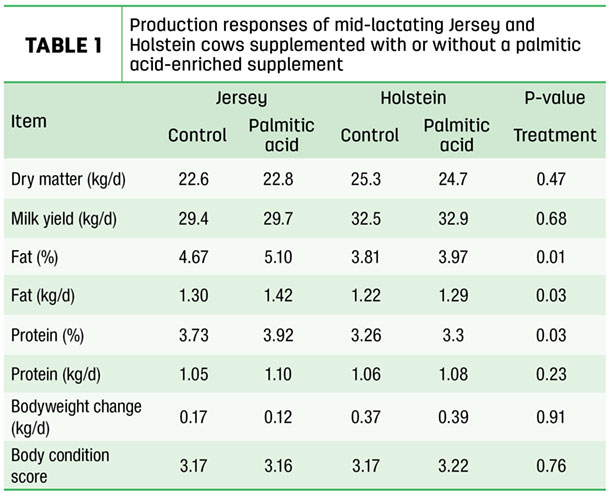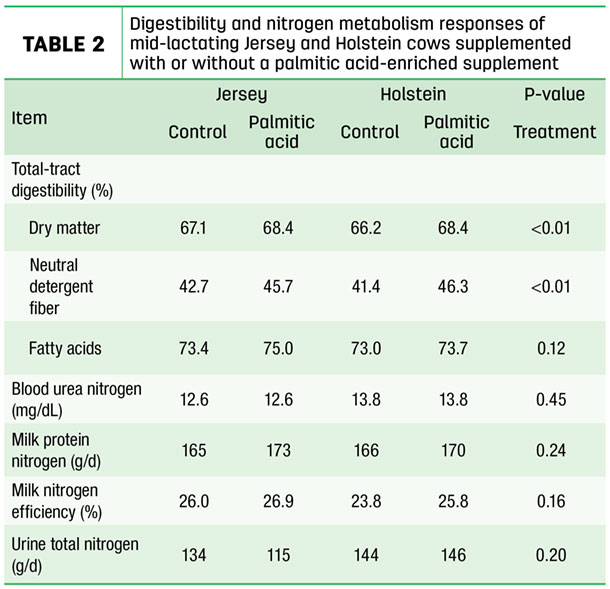Milkfat and protein yield are the major contributors to the price producers receive for milk in most Federal Milk Market Orders. This underlines the importance of focusing on increasing the yield of milkfat and protein and not milk yield per se in order to maximize milk price and income.
Several factors (such as genetics, management and nutrition) can affect the yield of milk components and, in the last few years, great attention has been given to increase the yield of milkfat.
Using supplemental fat can be an effective strategy to increase milk production and milkfat yield. Recent research indicated that the fatty acid profile of supplemental fat is a major factor affecting dairy cow performance.
Supplementation with palmitic acid has been shown to consistently increase the concentration and yield of milkfat across several studies with cows at different lactation stages. However, the effects of dietary palmitic acid supplementation have only been evaluated with Holstein cows, and it is well established that milk composition is largely affected by breed.
Across the U.S. dairy industry, Holstein and Jersey are the two most common dairy cattle breeds. Jersey cows have greater milkfat content and a greater proportion of short- and medium-chain milk fatty acids than Holstein cows.
Additionally, breed differences may affect the utilization and partitioning of supplemental fat as well as milkfat synthesis. Thus, a recent study was conducted to determine the effects of feeding a palmitic acid-enriched supplement on production responses of mid-lactation Holstein and Jersey cows.
A total of 80 cows (40 Jerseys and 40 Holsteins) from the Utah State University Caine Dairy Research Farm (Wellsville, Utah) were used in a randomized complete block design, and cows were assigned to either a control diet (no additional supplemental fat) or a palmitic acid diet (1.5% of diet dry matter of a palmitic acid supplement) fed for six weeks.
We did not observe a treatment by breed interaction for any production responses measured. Our results indicate that feeding palmitic acid consistently increased milkfat content and yield in both Holstein and Jersey cows compared with control.
In our study, palmitic acid treatment increased milkfat content (+0.30 percentage points) and milkfat yield (+100 grams per day) compared with control, which agrees with several previous studies that fed palmitic acid supplements to Holstein cows.
Also, compared with control, supplementing palmitic acid increased milk protein content (3.61% versus 3.50%) and tended to increase FCM (35.6 versus 34 kilograms per day) as well as ECM (35.7 versus 34.1 kilograms per day) (Table 1).

Our results indicate that feeding palmitic acid does not affect feed intake, feed intake as a percent of bodyweight, rumination time, bodyweight change or body condition score as most of the previous literature with mid-lactation Holstein cows suggests.
Neutral detergent fiber digestibility increased with palmitic acid supplementation in comparison with the control diet in both Holstein and Jersey cows (Table 2).

Also, compared with control, feeding palmitic acid increased dry matter digestibility but no difference was observed for total fatty acid digestibility.
Our nitrogen metabolism data suggests that palmitic acid, despite its ability to increase fiber digestibility (potentially providing more energy to the rumen microbes), does not enhance nitrogen utilization in the rumen. These results are not unexpected since higher fermentable carbohydrate loads have been shown to increase nitrogen utilization and incorporation rather than fiber-rich sources.
Interestingly, from our results, we estimated that transfer efficiency (additional fat yield/additional supplemental fat) was 36% and 21% for Jersey and Holstein cows, respectively.
For mid-lactating Holstein cows, the transfer efficiency from diet to milkfat ranged from 16% to 24% in previous studies feeding palmitic acid supplements, while using duodenal infusions of palmitic acid reported an apparent transfer of 47%.
Therefore, differences in the transfer efficiency and milkfat responses between Jersey and Holstein cows are likely explained by differences in mammary gland extraction and incorporation of these fatty acids into milkfat.
This indicates that Jersey cows may be more efficient in utilizing supplemental fatty acids and converting these into milkfat than Holstein cows. This deserves follow-up studies with other fatty acids and different lactation stages.
This study shows that a palmitic acid-enriched supplement improved milkfat yield and content and protein content in dairy cows consistently in both Jersey and Holstein cows.
Dietary fat supplements have the potential to increase profitability of dairy farms, but this would depend on the cost of the supplement relative to other diet ingredients, the magnitude of responses in relation to milk price and other intangibles related to reproduction and health.
Since transfer efficiency of supplemental fat (additional fat yield/additional supplemental fat) was greater for Jersey than Holstein cows, this may affect the return over investment of this nutrition strategy depending on the breed.






